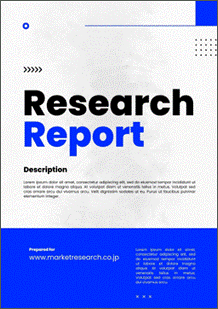 | • レポートコード:C-MOR-100408 • 出版社/出版日:Mordor Intelligence / 2019年8月 • レポート形態:英文、PDF、203ページ • 納品方法:Eメール(受注後2-3営業日) • 産業分類:エネルギー |
| Single User | ¥629,000 (USD4,250) | ▷ お問い合わせ |
| Multi User | ¥703,000 (USD4,750) | ▷ お問い合わせ |
| Site License | ¥888,000 (USD6,000) | ▷ お問い合わせ |
• お支払方法:銀行振込(納品後、ご請求書送付)
レポート概要
| 本調査レポートでは、バイオエタノールの世界市場について調査・分析し、バイオエタノールの世界市場規模、市場動向、市場環境分析、市場展望、セグメント別分析、地域別分析、関連企業情報など以下の構成でお届け致します。 |
Market Overview
The market for bio-ethanol is expected to grow at a CAGR of more than 5% during the forecast period of 2019 – 2024. One of the major factor driving the market is the growing demand from the automotive Industry. On the contraty, shifting focus towards bio-butanol is expected to hinder the growth of the market studied.
Automotive & Transportation industry dominated the market in 2018 and is expected to grow during the forecast period.
Technological advancements are likely to act as an opportunity in the future.
North America dominated the market across the globe with the largest consumption from the United States.
Key Market Trends
Increasing Demand from Automotive & Transportation Industry
Exhaust gases of bio-ethanol are much cleaner as it burns more cleanly. Bio-ethanol can be directly used in vehicles and acts in a similar fashion to conventional fuels.
Furthermore, bio-ethanol has a high-octane rating that enables high engine compression ratios which increases engine efficiency and performance.
Compared to conventional gasoline, bio-ethanol based fuel has a low volumetric energy density and requires more bio-ethanol per kilometer (by as much as 50%) when compared to gasoline.
The conversion of a conventional spark-ignition engine vehicle into a pure bio-ethanol engine simply requires adjustment of the timing (and electronic control systems where used) and the fitting of a larger fuel tank due to the fuel’s low energy density.
Low percentage bio-ethanol blends (up to E10) can readily be used by most conventional gasoline engines without the need for any modifications and can even slightly improve their performance.
The increasing preference for ecofriendly fuel is increasing the demand for bio-ethanol in the automotive & transportation sector.
North America Region to Dominate the Market
North America region dominated the global market share in 2018. The United States is the largest producer of bio-ethanol, globally, followed by Brazil, China, and Canada. It is also the largest consumer of bio-ethanol.
In the recent years, bio-ethanol production increased as a result of higher renewable fuel standard (RFS) targets and growth in domestic motor gasoline consumption, almost all of which is now blended with 10% ethanol by volume.
Moreover, the US pharmaceutical industry is also expanding at a rapid pace. According to the Centre of Medicare & Medicaid Services (CMS), the US National Health Expenditure is projected to grow by an average of 5.5% annually over the next decade.
Driven by biofuel policies, which aim to reduce greenhouse gas (GHG) emissions and increase domestic energy supply, US production and consumption of bio-ethanol have doubled over the years.
With rapid growth in corn-based biethanol in the U.S., advances in crop yields, energy use efficiency in fertilizer production, biomass-to-ethanol conversion rates, and energy efficiency in ethanol production, the demand for bio-ethanol has improved over the decade in the region.
These factors are also expected to drive the market during the studied period, in North America.
Competitive Landscape
The bio-ethanol market is fragmented and is dominated by very few players. Some of these major players include Cargill, Abengoa Bioenergy SA, Archer Daniels Midland Company, Pacific Ethanol, Inc., and Green Plains Inc, among others.
Reasons to Purchase this report:
The market estimate (ME) sheet in Excel format
Report customization as per the client’s requirements
3 months of analyst support
1 INTRODUCTION
1.1 Study Deliverables
1.2 Study Assumptions
1.3 Scope of the Study
2 RESEARCH METHODOLOGY
3 EXECUTIVE SUMMARY
4 MARKET DYNAMICS
4.1 Drivers
4.1.1 Growing Demand from the Automotive Industry
4.1.2 Increasing Government Initiatives
4.2 Restraints
4.2.1 Shifting Focus to Biobutanol
4.3 Industry Value-Chain Analysis
4.4 Porters 5 Force Analysis
4.4.1 Bargaining Power of Suppliers
4.4.2 Bargaining Power of Consumers
4.4.3 Threat of New Entrants
4.4.4 Threat of Substitute Products and Services
4.4.5 Degree of Competition
5 MARKET SEGMENTATION
5.1 Feedstock
5.1.1 Sugarcane
5.1.2 Corn
5.1.3 Wheat
5.1.4 Others
5.2 Application
5.2.1 Automotive and Transportation
5.2.2 Power Generation
5.2.3 Pharmaceutical
5.2.4 Cosmetics
5.2.5 Others
5.3 Geography
5.3.1 Asia-Pacific
5.3.1.1 China
5.3.1.2 India
5.3.1.3 Japan
5.3.1.4 South Korea
5.3.1.5 Rest of Asia-Pacific
5.3.2 North America
5.3.2.1 United States
5.3.2.2 Canada
5.3.2.3 Mexico
5.3.3 Europe
5.3.3.1 Germany
5.3.3.2 United Kingdom
5.3.3.3 Italy
5.3.3.4 France
5.3.3.5 Rest of Europe
5.3.4 South America
5.3.4.1 Brazil
5.3.4.2 Argentina
5.3.4.3 Rest of South America
5.3.5 Middle East & Africa
5.3.5.1 Saudi Arabia
5.3.5.2 South Africa
5.3.5.3 Rest of Middle East & Africa
6 COMPETITIVE LANDSCAPE
6.1 Mergers & Acquisitions, Joint Ventures, Collaborations, and Agreements
6.2 Market Share Analysis**
6.3 Strategies Adopted by Leading Players
6.4 Company Profiles
6.4.1 Abengoa Bioenergy SA
6.4.2 Algenol
6.4.3 Archer Daniels Midland Company
6.4.4 Cargill, Incorporated
6.4.5 DowDuPont
6.4.6 Ethanol Technologies
6.4.7 GranBio
6.4.8 Green Plains Inc.
6.4.9 Jilin Fuel Ethanol Co. Ltd. (CNPC)
6.4.10 Pacific Ethanol, Inc.
6.4.11 POET, LLC.
6.4.12 Raizen (incl. Shell)
6.4.13 Valero Marketing and Supply Company
7 MARKET OPPORTUNITIES AND FUTURE TRENDS
7.1 Technological Advancements